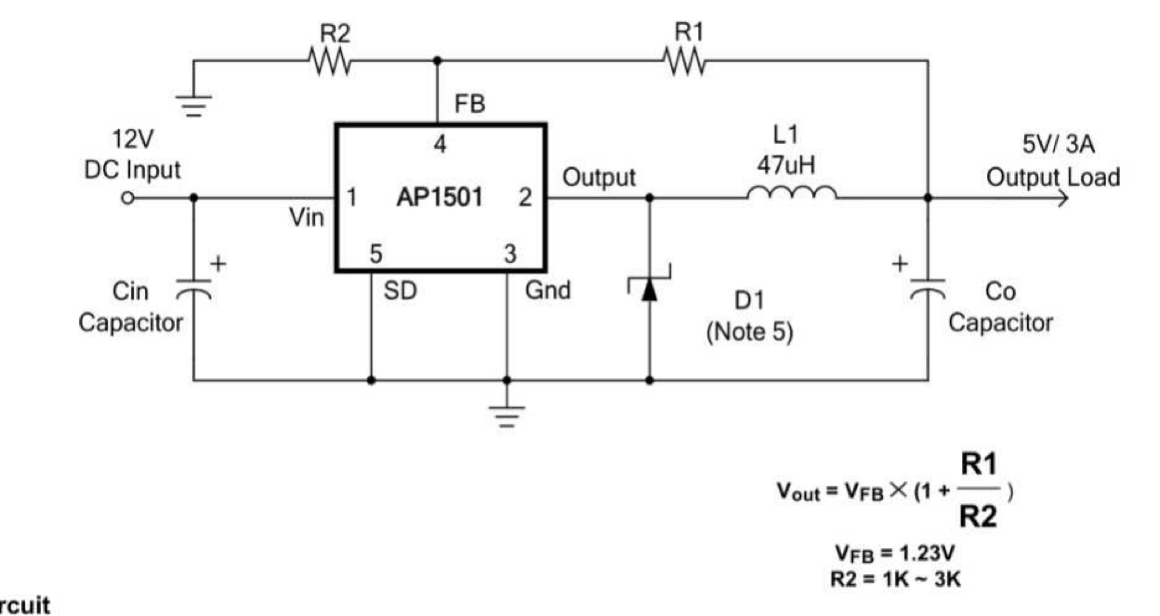Desford Flyers
DC - DC Buck Converter
LiPo driven Glow Driver
This glow driver has been marketed under the Prolux label, and it enables the use of a multi cell LiPo battery to drive a glow plug.
A three cell LiPo is nominally 12 volts and a glow plug requires approximately 1.5 volts. I was donated a faulty unit and on investigation I discovered that the internal circuitry was derived from the chip manufacturer's suggested design which is shown above. A simple replacement of the AP1501 chip affected a perfect repair.
The term Buck Converter seems to come from America and it describes the back-emf derived from the inductor L1 at the end of a current pulse which derives from the AP1501 chip. It's similar in principle to the effect which is used to provide high voltages to spark plugs in a petrol engine when the contact breaker opens.
Similar principles apply to the BEC or UBEC circuits which can be used to supply radio control receivers working at 5 volts from LiPo batteries of much higher voltages. This enables batteries to be fitted in planes which hold more than adequate capacity for a whole day's flying without the bother of frequent recharging at the field.
The UBEC circuitry is commonly fitted inside motor control circuitry in ESC units for electric planes and electric helicopters.
Some voltage converters are sold as being "linear" devices which use analogue voltage stabiliser circuitry to produce a steady 5 volts from a higher voltage battery. Their advantage supposedly being that they do not emit electrical interference which can affect the performance of radio receivers. Whilst this claim may be true of a poorly designed Buck-Converter design, the operation of an analogue device depends upon the voltage conversion being accomplished by reducing the voltage as waste heat. Thus there is little advantage in using a larger voltage battery.
A test on the UBEC shown below showed some interesting results. This particular unit is available from 4-Max and also Hobbyking.
The oscilloscope trace shows the ripple effects on top of the 5 volts output at only 20mV pk-pk and at a frequency of 500kHz. This is small in amplitude and because it is a smooth sine wave there is no evidence of saw-tooth or square waves which produce large amounts of harmonic radio frequency radiation.
This glow driver has been marketed under the Prolux label, and it enables the use of a multi cell LiPo battery to drive a glow plug.
A three cell LiPo is nominally 12 volts and a glow plug requires approximately 1.5 volts. I was donated a faulty unit and on investigation I discovered that the internal circuitry was derived from the chip manufacturer's suggested design which is shown above. A simple replacement of the AP1501 chip affected a perfect repair.
The term Buck Converter seems to come from America and it describes the back-emf derived from the inductor L1 at the end of a current pulse which derives from the AP1501 chip. It's similar in principle to the effect which is used to provide high voltages to spark plugs in a petrol engine when the contact breaker opens.
Similar principles apply to the BEC or UBEC circuits which can be used to supply radio control receivers working at 5 volts from LiPo batteries of much higher voltages. This enables batteries to be fitted in planes which hold more than adequate capacity for a whole day's flying without the bother of frequent recharging at the field.
The UBEC circuitry is commonly fitted inside motor control circuitry in ESC units for electric planes and electric helicopters.
Some voltage converters are sold as being "linear" devices which use analogue voltage stabiliser circuitry to produce a steady 5 volts from a higher voltage battery. Their advantage supposedly being that they do not emit electrical interference which can affect the performance of radio receivers. Whilst this claim may be true of a poorly designed Buck-Converter design, the operation of an analogue device depends upon the voltage conversion being accomplished by reducing the voltage as waste heat. Thus there is little advantage in using a larger voltage battery.
A test on the UBEC shown below showed some interesting results. This particular unit is available from 4-Max and also Hobbyking.
The oscilloscope trace shows the ripple effects on top of the 5 volts output at only 20mV pk-pk and at a frequency of 500kHz. This is small in amplitude and because it is a smooth sine wave there is no evidence of saw-tooth or square waves which produce large amounts of harmonic radio frequency radiation.
